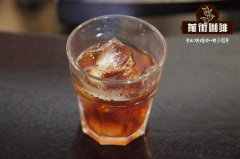Why is Blue Mountain coffee so expensive? why do you use oak barrels to hold raw beans?

Professional coffee knowledge exchange more coffee bean information please follow the coffee workshop (Wechat official account cafe_style)
Blue Mountain Coffee is a coffee bean brand grown in a limited area of the Blue Mountain Mountains of Jamaica at an altitude of 800-1200 meters. It usually grows on steep slopes, sometimes as high as 60 degrees and requires manual mining. It is characterized by its high aroma and delicate taste. Because of its high aroma, it is often mixed with other raw beans and more than 80% of it is exported to Japan.
The production of coffee is the same as that of ordinary agricultural products, and it has been greatly affected by the weather. In 1969, the production of Toshiyama coffee was affected by the weather, which caused production difficulties. UCC enterprises in Japan provided assistance and introduced ecological planting methods.
In recognition of the assistance provided by Japanese enterprises, Toya signed an agreement with Japan in 1972 to provide 90% of its annual output to the Japanese market. the remaining 10% is about 3500 barrels (70 kilograms in oak barrels) and then sold on the market (the only coffee packed in oak barrels).
Therefore, Luoshan Coffee is very popular in the market, which has established its dominant position in the coffee market.
Output is scarce
Because it is only planted in limited areas, the harvest is very low. The output of raw beans in 2014 was about 875 metric tons. From July 2013 to July 2014, the amount of raw beans exported by Jamaica to Japan was 283 tons, plus 440 metric tons * 2. The total is 723 tons. After baking, 578 tons of ripe beans will be produced. Taking 15 grams as a cup, about 38.56 million cups, the average person in Japan drinks less than one cup of Blue Mountain coffee in a year. In fact, Blue Mountain coffee beans are the same as other coffee beans grown in Jamaica, but because they are cultivated in a harsh environment and screened through strict inspection, they produce a very meticulous taste. In 1953, the Jamaican government drew a clear line between the Blue Mountains and other areas in accordance with the law, stipulating that the name of Blue Mountain Coffee should not be used for coffee in areas other than the Blue Mountains. Only coffee made in selected areas of the Blue Mountains can be called "Blue Mountain Coffee".
The origin of the barrel:
Of all the coffee, only Blue Mountain is barreled, and other coffee exits are in sacks. It is said that from the mid-18th century, flour shipped from England to Jamaica during the British colonial period was recycled in empty buckets and used to transport coffee and rum. The buckets used today are all wood from temperate forests in the United States. the advantage of buckets is to absorb and release internal and external humidity without much change, which can alleviate sudden temperature changes in the process of transportation. Another barrel sealed off coffee aroma, can maintain the best coffee quality, but the additional cost will be higher.
Important Notice :
前街咖啡 FrontStreet Coffee has moved to new addredd:
FrontStreet Coffee Address: 315,Donghua East Road,GuangZhou
Tel:020 38364473
- Prev

Japan% Coffee how about Japanese 100% Coffee arabica Coffee hungry
Professional coffee knowledge exchange more coffee bean information Please follow the coffee workshop (Wechat official account cafe_style) the Japanese are no less infatuated with coffee than tea, coffee shops can be said to be everywhere, as the neon coffee industry's online celebrity cafe% Arabica, unlike other imported coffee brands, but from design and decoration to coffee quality, have made their own characteristics. Fresh and fresh
- Next

What kind of coffee is medium fruit coffee? the relationship between fruit coffee and robusta (Robusta)
Professional coffee knowledge exchange more coffee bean information please follow the coffee workshop (Wechat official account cafe_style) Coffee originated in Africa, there are many varieties. Each variety is related to specific climatic conditions and a certain altitude. The wild coffee tree is an evergreen shrub, 3 to 3.5 meters high, with small white flowers on its branches and a jasmine fragrance. The fruit is 1.5 to 1.8 cm long.
Related
- Beginners will see the "Coffee pull flower" guide!
- What is the difference between ice blog purified milk and ordinary milk coffee?
- Why is the Philippines the largest producer of crops in Liberia?
- For coffee extraction, should the fine powder be retained?
- How does extracted espresso fill pressed powder? How much strength does it take to press the powder?
- How to make jasmine cold extract coffee? Is the jasmine + latte good?
- Will this little toy really make the coffee taste better? How does Lily Drip affect coffee extraction?
- Will the action of slapping the filter cup also affect coffee extraction?
- What's the difference between powder-to-water ratio and powder-to-liquid ratio?
- What is the Ethiopian local species? What does it have to do with Heirloom native species?

